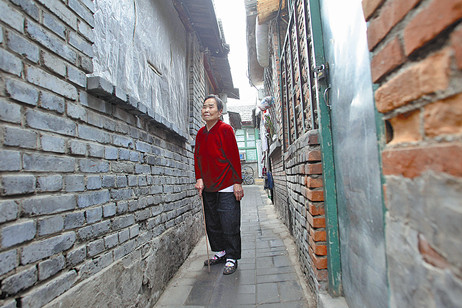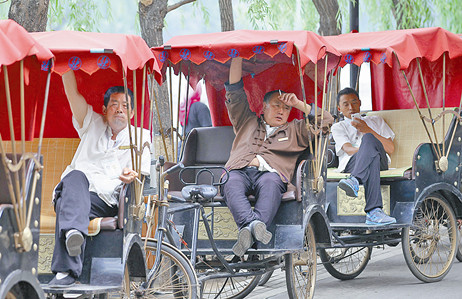

In the capital's historic Shichahai community, residents hope redevelopment plans won't destroy the hutong way of life, Chen Nan reports.
For 80-year-old Ma Lingpeng and his 76-year-old wife Meng Zhaohui, living out the rest of their lives in comfort and happiness means living in their courtyard, walking around the nearby Shichahai lakes and watching their grandson growing up.
Behind a newly painted red door is their cozy, tidy courtyard home, which has two bedrooms, kitchen and bathroom, about 120 square meters.
Located in Baimixiejie, a 200-meter-long, 5-meter-wide hutong (lane) of the Shichahai area, Ma's house is close to the Ping'an Avenue and the Lotus Market, a popular tour site on the west side of Houhai. His great-grandfather, who was a chef working for the imperial families, moved into the courtyard first and Ma's extended family has lived here for more than 200 years. Ma has three sons, who all got married and had children. His youngest son and his family live with the old couple.
|
An elderly hutong resident at Shichahai takes a rest in the courtyard. Photos by Zou Hong / China Daily |
|
The Shichahai area is a popular tour site crowded with visitors every day. |
"I was born and grew up here," he says, waving his bamboo fan. His face is creased with wrinkles around his eyes and mouth. "You see the trees outside our hutong? They were planted the day we got married in 1956."
Ma lives in what can be considered the old Beijing. Hidden among tall trees and gray walls, winding hutong and courtyards form the neighborhoods, where people go about everyday life. They buy daily supplies at closet-sized stores, build pigeon nests on the roofs, and visit neighbors without changing their pajamas.
In May, the Xicheng district government announced plans to renovate the Shichahai area. Work on the project, which stretches from Drum and Bell Towers to the north and Ping'an Avenue, including the Baimixiejie Hutong area to the south, will start in September and October.
Plans include an underground square that connects with the Shichahai station of Beijing subway line 8. Two-story buildings along the southern extension of Beijing's central axis will be built in the style of Ming (1368-1644) and Qing (1644-1911) dynasties.
According to Sun Jinsong, director of Xicheng District Information Office, the total investment in this project will be 8.3 billion yuan ($1.4 billion), which covers 15.6 hectares and involves more than 1,000 families living in the area. But the number of residents who will have to move out has not been decided yet.
"We will use the same policy as in Yangmeizhuxiejie of Qianmen area, listening to local residents' wishes," says Sun, referring to the restoration of Qianmen, a well-known hutong neighborhood near Tian'anmen Square. In 2008, the once ramshackle and over-populated area is now a wide pedestrian street.
According to Sun, more than 500 families among the total number of 1,700 there were willing to move out and were given compensation for new housing.
"For those who didn't want to leave, the local government paid to improve their living conditions, such as building more public toilets, installing natural gas pipes and renovating old houses," says Sun.
Ancient legacy
The water area of Shichahai was called Haizi before the Yuan Dynasty (1279-1368). With the nearby Beihai Lake becoming an imperial back garden, around 20 temples were built in the area of Shichahai.
In its heyday, Shichahai, which is composed of three lakes, Qianhai, Houhai and Xihai, formed the northern part of the water system of the Grand Canal, which connected Beijing with other cities of China. Wooden boats carried goods from southern China into the imperial capital, making the area a busy commercial center.
The location near the Forbidden City has long attracted many senior officials and celebrities to the area. As a rare waterfront in the capital, it has been a sanctuary for local residents from the daily hustle and bustle for centuries.
However, the downtown area has declined. Today, the aging community is troubled with heavy traffic jams, a jumble of stores and a polluted environment worsened by tourists and an increasing number of residents.
"The heart of the plan is to preserve the area," says Wu Chen, chief architect in charge of the plan.
"When people think of Shichahai, the lakes and bar street come into mind first, which are tranquil and very Beijing. But when you actually go there, you feel annoyed by the congestion," he says after many visits to the area.
"The central axis of Beijing is expected to be included in the Tentative List of UNESCO World Heritage Sites of China, and as the extension of the central axis, Shichahai should regain its glory," he says.
He admits that the project is complicated and takes time because of the density of the population in the area.
The core issue for restoration is to respect people living there, says He Shuzhong, founder of Beijing Cultural Heritage Protection Center, an NGO based in Beijing.
"You should give the people confidence and stability," he says. "What's the value of history? I think it's all about the people and their stories."
Residents nervous
Residents are concerned about the project. Since May, people have posted thousands of comments on the official weibo of the Xicheng government. Some worry that the Shichahai area will be the next Nanluoguxiang, a former hutong area that's become a commercial market. Some are practical, fearing that even with compensation they can't afford an apartment in the city's skyrocketing housing market. Others are simply attached to their homes.
"My son works nearby and my grandson goes to school nearby. Supermarkets, parks and hospitals are not far, which is very convenient," says Ma. "We don't want our lives to be disturbed."
"We've heard that the houses near the lakes are nearly 400,000 yuan per square meter," says Ma's wife Meng Zhaohui. "But it's not a money issue. We spent our whole lives here. We don't want to leave our roots."
According to the couple, it's not the first time plans were made to renovate the area. Around 2000, a real estate company came to visit the households of Baimixiejie Hutong, intending to build shopping malls there.
"My neighbors told me not to repair houses because maybe we would be asked to move out the next day," recalls Ma. "But this is my home and I have the duty to maintain it."
Local official Sun says he understands why people are worried, acknowledging that recent large-scale demolitions have wiped out many hutong communities.
The government, he says, believes that "the Shichahai area will have a new look while maintaining its own identity".
For local residents, the Shichahai area is already losing its original charm. "Today the area is very noisy," says Wei Lianyu, 50, who was born and raised in Baimixiejie Hutong.
The public toilet, Wei says, was the first five-star toilet in Beijing with air conditioning and infrastructure. But as more tourists came, the toilet became very dirty, he says, and there are long lines on weekends.
Wei's family lives in a courtyard shared by five families. He says that in his childhood, he knew everyone living in the hutong and they shared food and helped each other. Today he doesn't know new arrivals in the neighborhood.
"We will miss our old neighbors if we have to move to the Huilongguan area of the north Sixth Ring Road," he says. "We have lived here for generations. We don't want to leave. We hope that they can find a balanced way."
Contact the writer at chennan@chinadaily.com.cn.
|
  From top to above: Ma Lingpeng and his wife Meng Zhaohui say they don't want to leave the hutong, where Ma's extended family has lived for more than 200 years. An elderly woman at the narrow Baimixiejie Hutong. Rickshaw men wait for customers at the Shichahai area. |